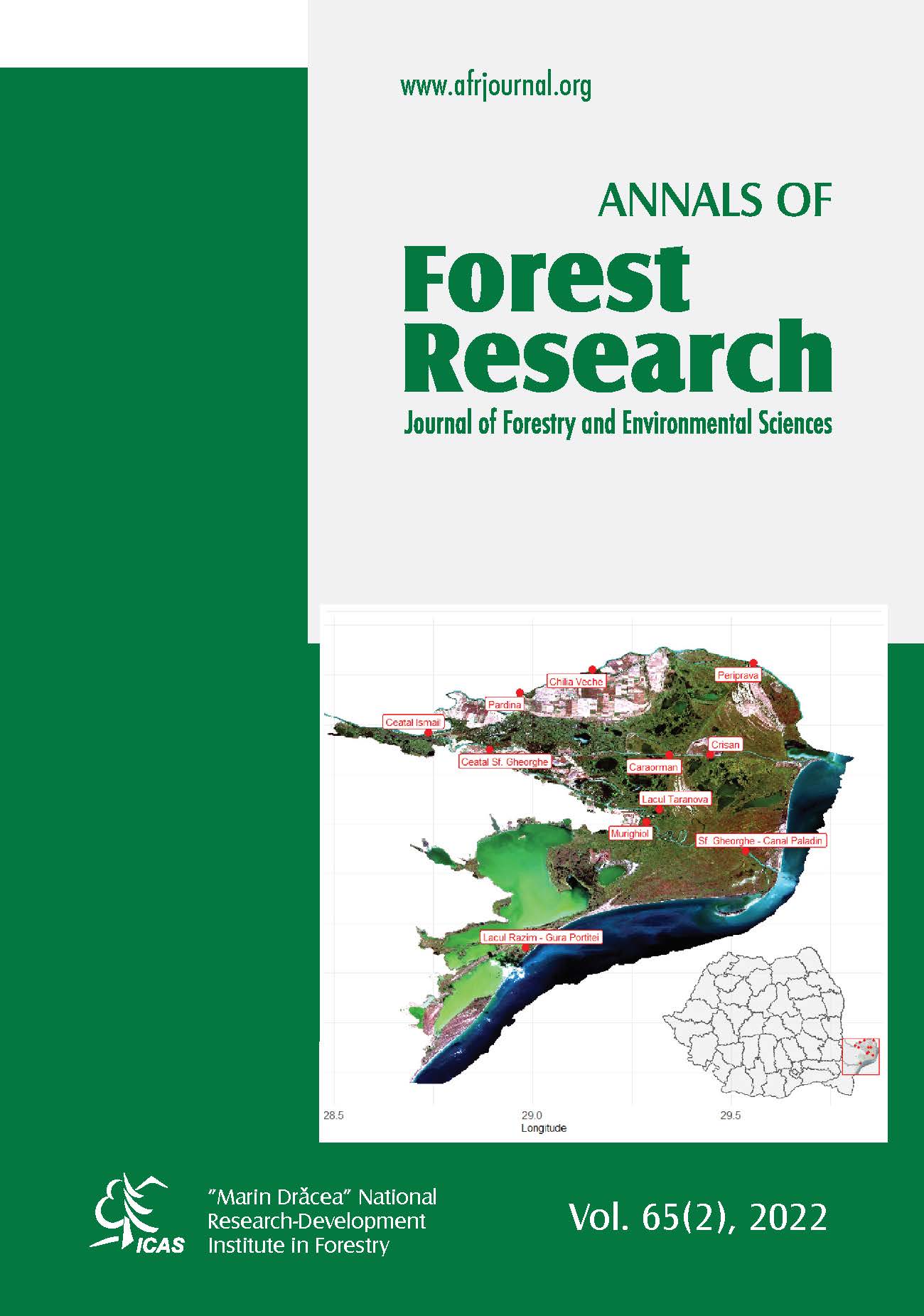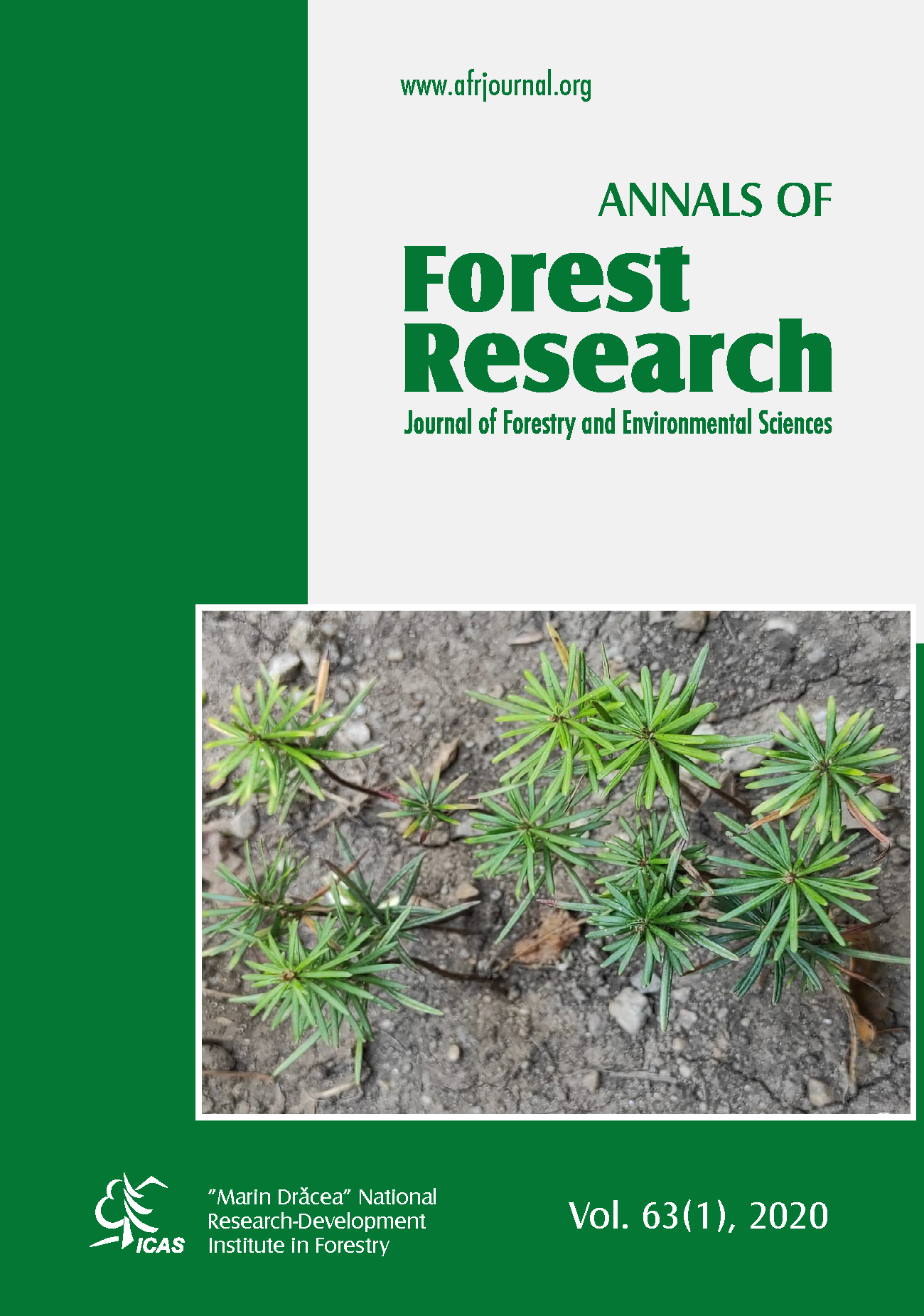Gender inequalities in Transylvania's largest peri-urban forest usage
DOI:
https://doi.org/10.15287/afr.2022.2757Keywords:
peri-urban forest, gender, social values, recreational value, healthAbstract
Urban green spaces (public gardens, parks, urban and peri-urban forests) offer multiple-use opportunities and spaces for recreational activities and played a key role in supporting mental and physical health of dwellers during covid-19 pandemic, being ones of few places where outdoor and social activities where allowed. This study was conducted in Brașov city (also known as Kronstadt, by its German name), the second largest metropolitan area of Romania and surrounded by a significant area of peri-urban forests in Transylvania. Brașov city own just 5.62 sqm of urban green space/inhabitant, one of the lowest in the country, so the presence of a large peri-urban forest area become very valuable for locals and tourists visiting the area. Due to its importance and because understanding visitors' expectations and perceptions is a key element to support decision-makers and ensure proper management of these forests, the Brașov's forests administrator (Kronstadt Local Public Forest District – RPLPK) decided to investigate how dwellers generally interact with the peri-urban forests and to identify opportunities for improving the capacity of forests in providing social and recreational services. Data were collected through the administration of CAWI (computer assisted web interview) to 314 respondents at beginning of 2021, at exactly one year distance after the pandemic lockdown was imposed all around the country. Analyzing the participants responses, a surprising fact become evident: the use of peri-urban forest is not gender equal, women being less able than men to access these green natural spaces and, therefore, to uptake the benefits provided by the peri-urban forests.
References
Alessandro P., De Meo I., Grilli G., Notaro S., 2022. Valuing nature-based recreation in forest areas in Italy: An application of Travel Cost Method (TCM). Journal of Leisure Research, 1-20. https://doi.org/10.1080/00222216.2022.2115328
Barton J., Pretty J., 2010. What is the best dose of nature and green exercise for improving mental health? A multi-study analysis. Environmental Science and Technology, 44: 3947–3955. https://doi.org/10.1021/es903183r
Baumeister C.F., Gerstenberg T., Plieninger T., & Schraml U., 2022. Geography of disservices in urban forests: public participation mapping for closing the loop. Ecosystems and People, 18(1): 44-63. https://doi.org/10.1080/26395916.2021.2021289
Berman M.G., Jonides J., Kaplan S., 2009. The Cognitive Benefits of Interacting with Nature. Psychological Science 19(12): 1207-1212. https://doi.org/10.1111/j.1467-9280.2008.02225.x
Beckmann-Wübbelt A.B., Fricke A., Sebesvari Z., Yakouchenkova I. A., Frohlich K., Saha S., 2021. High public appreciation for the cultural ecosystem services of urban and peri‑urban forests during the COVID-19 pandemic. Sustainable Cities and Society 74, 103240. https://doi.org/10.1016/j.scs.2021.103240
Birks C., Féménias D., Machemehl C., 2022. Citizen participation in urban forests: Analysis of a consultation process in the metropolitan area of Rouen Normandy. Urban Planning, 7(2): 174-185. https://doi.org/10.17645/up.v7i2.4997
Bjärstig T., Sténs A., 2018. Social Values of Forests and Production of New Goods and Services: The Views of Swedish Family Forest Owners, Small-scale Forestry 17:125–146. https://doi.org/10.1007/s11842-017-9379-9
Brasov Metropolitan Agency for Sustainable Development, 2019. www.metropolabrasov.ro/despre-amb/zona-metropolitana-brasov/
Corbu I., 2020. Brașov Parks surface, 2020, Brașovul verde: https://www.facebook.com/notes/usr-bra%C8%99ov/bra%C8%99ovul-verde-o-analiz%C4%83-de-ioan-corbu/2495800130680901/
Cristea M., Mare C., Moldovan C., Farole T, Vințan A, Park J, Garrett K P, Ionescu-Heroiu M, 2017. Magnet cities: Migration and commuting in Romania. World Bank, 2017, Bucharest. http://localhost:4000//entities/publication/f87062f1-6d6d-52d7-9a2c-d90ef4433b03
da Schio N., Phillips A., Fransen K., Wolff M., Haase D., Ostoic S. K., Zivojinovic I., Vuletic D., Derks J., Davies C., Lafortezza R., Roitsch D., Winkel G., De Vreese R., 2021. The impact of the COVID-19 pandemic on the use of and attitudes towards urban forests and green spaces: Exploring the instigators of change in Belgium. Urban Forestry & Urban Greening 65, 127305. https://doi.org/10.1016/j.ufug.2021.127305
De Meo I., Becagli C., Cantiani M.G., Casagli A., & Paletto A., 2022. Citizens' use of public urban green spaces at the time of the COVID-19 pandemic in Italy. Urban Forestry & Urban Greening 77, 127739. https://doi.org/10.1016/j.ufug.2022.127739
Donovan G.H., Butry D.T., Michael Y.L., Prestemon J. P., Liebhold A.M., Gatziolis D., Mao M.Y., 2013. The Relationship Between Trees and Human Health. American Journal of Preventive Medicine 44(2):139–145. doi: 10.1016/j.amepre.2012.09.066
Elbakidze M., Dawson L., Milberg P., Mikusiński G., Hedblom M., Kruhlov I., Yamelynets T., Schaffer C., Johansson K.E., Grodzynskyi M., 2022. Multiple factors shape the interaction of people with urban greenspace: Sweden as a case study. Urban Forestry & Urban Greening, 74, 127672. https://doi.org/10.1016/j.ufug.2022.127672
European Commission 2022. The available public green in European cities per inhabitant: https://urban.jrc.ec.europa.eu/thefutureofcities/space-and-the-city#the-chapter
Gafta D., Schnitzler A., Closset-Kopp D., Cristea V., 2021. Neighborhood-based evidence of tree diversity promotion by beech in an old-growth deciduous-coniferous mixed forest (Eastern Carpathians). Annals of Forest Research 64(1): 13-30. https://doi.org/10.15287/afr.2020.2143
Google 2022. www.gstatic.com/covid19/mobility/2022-05-08_RO_Bra%C8%99ov_County_Mobility_Report_ro.pdf
Grima N., Corcoran W., Hill-James C., Langton B., Sommer H., Fisher B., 2020. The importance of urban natural areas and urban ecosystem services during the COVID-19 pandemic. PLoS ONE 15(12): e0243344. https://doi.org/10.1371/journal.pone.0243344
Guan H., Wei H., He X., Ren Z., An B., 2017. The tree-species-specific effect of forest bathing on perceived anxiety alleviation of young-adults in urban forests. Annals of Forest Research, 60(2): 327-341. https://doi.org/10.15287/afr.2017.897
Hegetschweiler K.T., Wartmann F.M., Dubernet I., Fischer C., Hunziker M., 2022. Urban forest usage and perception of ecosystem services–A comparison between teenagers and adults. Urban Forestry & Urban Greening 74, 127624. https://doi.org/10.1016/j.ufug.2022.127624
Kovács B., Uchiyama Y., Miyake Y., Quevedo J.M.D., Kohsaka R., 2022. Capturing landscape values in peri-urban Satoyama forests: Diversity of visitors' perceptions and implications for future value assessments. Trees, Forests and People 10, 100339. https://doi.org/10.1016/j.tfp.2022.100339
Lin B., Fuller R., Bush R., Gaston K., Shanahan D., 2014. Opportunity or orientation? Who uses urban parks and why. PLoS One 9(1), e87422. https://doi.org/10.1371/journal.pone.0087422
Morris J., O'Brien L., Ambrose-Oji B., Lawrence A., Carter C., 2011. Access for all? Barriers to accessing woodlands and forests in Britain. Local Environment: The International Journal of Justice and Sustainability 16(4): 375-396. http://dx.doi.org/10.1080/13549839.2011.576662
Nitya R.A.O., Patil S., Singh C., Parama R.O.Y., Pryor C., Poonacha P., Genes M., 2022. Cultivating sustainable and healthy cities: A systematic literature review of the outcomes of urban and peri-urban agriculture. Sustainable Cities and Society 85, 104063. https://doi.org/10.1016/j.scs.2022.104063
O'Brien L., De Vreese L., Atmiş E., Olafsson A.S., Sievänen T., Brennan M., Sánchez M., Panagopoulos T., de Vries S., Kern M., Gentin S., Saraiva G., Almeida A., 2017. Social and Environmental Justice: Diversity in Access to and Benefits from Urban Green Infrastructure – Examples from Europe, The Urban Forest, Future City book series 7: 153–190. https://doi.org/10.1007/978-3-319-50280-9_15
Oviedo M., Drescher M., Dean J., 2022. Urban greenspace access, uses, and values: A case study of user perceptions in metropolitan ravine parks. Urban Forestry & Urban Greening,70, 127522. https://doi.org/10.1016/j.ufug.2022.127522
Park S.H., Chang C., 2022. Impact of Changes in Forest Use Caused by the COVID-19 Pandemic on the Perception of Forest Ecosystem Services in the Republic of Korea. Sustainability 14(17), 10914. https://doi.org/10.3390/su141710914
Pelleri F., Becagli C., Sansone D., Bianchetto E., Bidini C., & Manetti M.C., 2021. New silvicultural approaches for multipurpose management in beech forests. Annals of Forest Research, 64(2): 87-103. https://doi.org/10.15287/afr.2021.2226
Pieratti E., Paletto A., De Meo, I., Fagarazzi C., Migliorini M.G.R., 2019. Assessing the forest-wood chain at local level: A Multi-Criteria Decision Analysis (MCDA) based on the circular bioeconomy principles. Annals of Forest Research 62(2): 123-138. DOI: 10.15287/afr.2018.1238
Plieningera T., Dijksb S., Oteros-Rozasc E., Bielingd C., 2013. Assessing, mapping, and quantifying cultural ecosystem services at community level. Land Use Policy 33: 118– 129. https://doi.org/10.1016/j.landusepol.2012.12.013
Rise Consortium 2018. www.riseconsortium.com/10-reasons-why-you-should-invest-in-brasov/
Scarneci-Domnisoru F., Csesznek C., 2022. The importance of the environment during the isolation caused by the Covid-19 pandemic. A visual essay. 2022. Bulletin of the Transilvania University of Brasov 15(64)(1):31-44. https://doi.org/10.31926/but.ssl.2021.15.64.1.3
Schipperijn J., Ekholm O., Stigsdotter U.K., Toftager M., Bentsen P., Kamper-Jørgensen F., Randrup T.B., 2010. Factors influencing the use of green space: Results from a Danish national representative survey. Landscape and Urban Planning 95(3): 130-137. https://doi.org/10.1016/j.landurbplan.2009.12.010
Su K., Ordóñez C., Regier K., & Conway T.M., 2022. Values and beliefs about urban forests from diverse urban contexts and populations in the Greater Toronto area. Urban Forestry & Urban Greening 72, 127589. https://doi.org/10.1016/j.ufug.2022.127589
Tu G., Abildtrup J., & Garcia S., 2016. Preferences for urban green spaces and peri-urban forests: An analysis of stated residential choices. Landscape and Urban Planning 148: 120-131. https://doi.org/10.1016/j.landurbplan.2015.12.013
Tudose N.C., Marin M., Cheval S., Ungurean C., Davidescu S.O., Tudose O.N., Mihalache A.L., Davidescu A.A., 2021. SWAT Model Adaptability to a Small Mountainous Forested Watershed in Central Romania. Forests. 12(7): 860. https://doi.org/10.3390/f12070860
Uchiyama Y., Kohsaka R., 2022. Visiting peri-urban forestlands and mountains during the COVID-19 pandemic: Empirical analysis on effects of land use and awareness of visitors. Land 11(8), 1194. https://doi.org/10.3390/land11081194
Wang Y., Niemelä J., Kotze D.J., 2022. The delivery of Cultural Ecosystem Services in urban forests of different landscape features and land use contexts. People and Nature 4(5), 1369-1386. https://doi.org/10.1002/pan3.10394
Zhou T., Koomen E., van Leeuwen ES., 2018. Residents' preferences for cultural services of the landscape along the urban–rural gradient. Urban Forestry & Urban Greening 29: 131–141. https://doi.org/10.1016/j.ufug.2017.11.011Downloads
Published
Issue
Section
License
All the papers published in Annals of Forest Research are available under an open access policy (Gratis Gold Open Access Licence), which guaranty the free (of taxes) and unlimited access, for anyone, to entire content of the all published articles. The users are free to "read, copy, distribute, print, search or refers to the full text of these articles", as long they mention the source.
The other materials (texts, images, graphical elements presented on the Website) are protected by copyright.
The journal exerts a permanent quality check, based on an established protocol for publishing the manuscripts. The potential article to be published are evaluated (peer-review) by members of the Editorial Board or other collaborators with competences on the paper topics. The publishing of manuscript is free of charge, all the costs being supported by Forest Research and Management Institute.
More details about Open Access:
Wikipedia: http://en.wikipedia.org/wiki/Open_access






